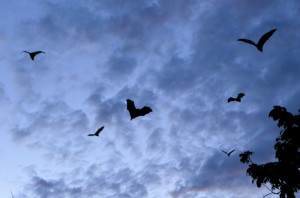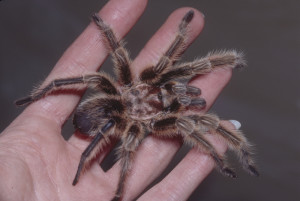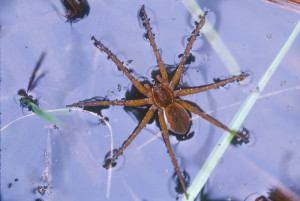Okay, let’s see how you did!
1. FALSE, Bats are NOT blind. Like most animals, they have eyes and can see in the dark about as well as most people. When hunting however, they rely on echolocation, sending out high pitched signals that bounce off of things and return to them, giving them a “visual” image of their surroundings. They are amazing, and can detect an object THINNER THAN A HUMAN HAIR! 
2. FALSE Spiders are NOT insects. Spiders are related to insects in that both lack a backbone and have a hard external skeleton. But spiders have two body parts and 4 pairs of legs. Insects have three body parts and three pairs of legs.
3. FALSE, NO spiders are poisonous but all but two are venomous. Poisonous and venomous are not the same thing. Poisonous plants or animals produce a poison that is ingested. Venomous animals produce a venom that is injected. These are two different things.
4. TRUE More people die EVERY YEAR from their own pets than have died from bat rabies in the last 30 years. Rabies in bats is not a given. In fact, less than one half of one percent is said to carry the deadly disease. When a bat becomes infected, it usually leaves the colony and goes off by itself to die, unlike other animals like raccoons or skunks who may become aggressive. One should never touch or handle a bat, especially one that is found on the ground. Tell your children not to handle ANY WILD ANIMAL!
5. FALSE Most bats do not live in caves though Hollywood has made it seem otherwise. Bats do not all live in colonies as some, like the Red Bat, are solitary. By day they hang from tree branches, looking like a leaf. Others live in hollow trees or under bark.
6. TRUE Some bats can have a SIX FOOT wingspan! This is an amazing fact, but a fact nevertheless! The largest bat in the world is a flying fox with a wingspan of 6 feet! They eat fruit and live in tropical regions like parts of Thailand, Australia, and Africa.
7. FALSE Not all spiders spin webs. All are capable of producing silk from their spinnerets, but not all make webs. Instead, many hunt much like a fox or lion does, by stalking their prey or by waiting for it to come to them.
 8. FALSE Tarantulas are NOT one of the most deadly spiders in the world. They are in fact one of the world’s least aggressive and dangerous spiders. Their venom has about as much toxicity as a bee sting and they rarely waste it on a human anyway, as we are much too big for them to eat. When threatened, they can defend themselves by flinging long needle-like barbed hairs on its abdomen. Tarantulas are amazingly long-lived for their size, living as much as 30 years!
8. FALSE Tarantulas are NOT one of the most deadly spiders in the world. They are in fact one of the world’s least aggressive and dangerous spiders. Their venom has about as much toxicity as a bee sting and they rarely waste it on a human anyway, as we are much too big for them to eat. When threatened, they can defend themselves by flinging long needle-like barbed hairs on its abdomen. Tarantulas are amazingly long-lived for their size, living as much as 30 years!
And now for some multiple choice questions:
9. D. More than 1000 How many species of BATS are there in the world? Bats make up more than a quarter of all the mammals on earth. They are the ONLY true flying mammal, as flying squirrels do not really fly, despite their name suggesting otherwise. Instead, flying squirrels GLIDE from a higher spot to a lower spot. Bats on the other hand truly FLY! Their hands are their wings, with thin membranes covering their long fingers.
 10. E. More than 30,000 How many species of SPIDERS are there in the world? Actually scientists have named more than 50,000 but many suspect this is only about a quarter of all those that actually exist! Amazing! We just haven’t discovered and named them yet.
10. E. More than 30,000 How many species of SPIDERS are there in the world? Actually scientists have named more than 50,000 but many suspect this is only about a quarter of all those that actually exist! Amazing! We just haven’t discovered and named them yet.
11. B. 30 years How long is the average life span of a BAT? An amazing fact about bats is that they SHOW NO SIGNS OF AGING. Females can give birth right up until their last year of life and they can live for 30 years! Scientists are studying them to help humans reduce the signs of aging. We can learn a lot from this small, but valuable animal.
12. C 1000! How many insects can an average sized bat eat in ONE HOUR. Bats that eat insects, called insectivores, can eat a LOT OF INSECTS! In one night a colony of Mexican Freetailed bats can eat more than a ton of insects. This is a lot of insects that might do a lot of crops damage. Think about how much we would need to pay the bats for this very valuable service. Mosquitoes are on the menu for bats so having them around your house benefits you in that you will have less mosquitoes!
13. D all of the above Fruit BATS are responsible for the pollination of which of the following crops? There are over 300 species of fruit that rely on bats for pollination. Avocados, dates, mangos, bananas, guavas, and peaches are just a few.
How did you do? Want to help bats? Click HERE to learn some things you can do to help these important and amazing animals.
Want to read more about BATS, click HERE
Want to read more about SPIDERS, click HERE


1 thought on “Answers to the Halloween Quiz”
Comments are closed.